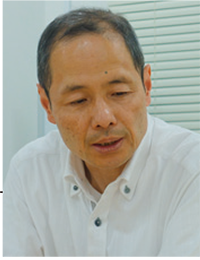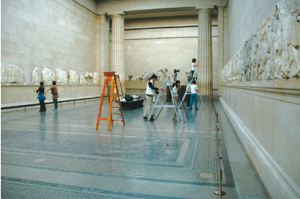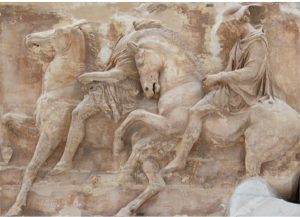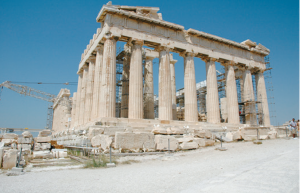キーワード: パルテノン、彫刻、古代ギリシア、古典考古学、美術史
 パルテノン神殿の装飾は、紀元前5世紀前半に戦われたペルシアに対する民族戦争について表現するために作られたものだと考えられています。古代ギリシアの人々は何を美術に求めていたのでしょうか。その装飾の意味を考え、パルテノン神殿の装飾に新しい問題提起を行うため、本リサーチユニットでは古典期アテナイ美術について解明し、ロンドンの大英博物館と、アテネの新アクロポリス美術館の彫刻群を撮影し、調査を行います。
パルテノン神殿の装飾は、紀元前5世紀前半に戦われたペルシアに対する民族戦争について表現するために作られたものだと考えられています。古代ギリシアの人々は何を美術に求めていたのでしょうか。その装飾の意味を考え、パルテノン神殿の装飾に新しい問題提起を行うため、本リサーチユニットでは古典期アテナイ美術について解明し、ロンドンの大英博物館と、アテネの新アクロポリス美術館の彫刻群を撮影し、調査を行います。

図1:ロンドン、大英博物館、パルテノン彫刻展示室における調査 2008 年(長田撮影)
アイデンティティの確立
パルテノン神殿は、神殿自身がペルシアに対するギリシア世界の勝利を象徴しています。自由と民主主義を標榜するアテナイは、このような形で、ギリシア世界に政治的メッセージを伝えていたようです。例えば、巨人族、アマゾン族、トロヤ人、ケンタウロス族という「他者」像という、現実には存在しない神話の内容が積極的に利用されました。自民族のアイデンティティを確立し、異民族の特徴を定型化する際に、美術作品が社会的メディアの役割を果たしたと考えられます。

図2:パルテノン・フリーズ浮彫西面アテネ、新アクロポリス美術館 2011年(長田撮影)
社会的メディア?? それとも!?

図3:パルテノン神殿 東正面より 2007 年(長田撮影)
しかしながら、その社会的メディアというのも、あまりにも今日的な見方で、もしかしたら時代錯誤と言うことが考えられるのではないでしょうか。パルテノン神殿は、社会的メディアの一つという考えがある一方で、ただ信仰の産物だったともいえます。8割が信仰の産物で、2割が社会的メディアの役割なのか、それとも逆なのかということは、その当時の生きている人に聞いてみなければわかりません。
その他にも、パルテノン神殿というのはギリシアのオリエント文化に対する優位性を保つために建設されたと考えられますが、ギリシアの内紛がおこると有力者はペルシアに亡命しており、ギリシアとペルシアは戦争時には敵味方であったとはいえ、上層階級同士は非常にコンタクトが多く、ギリシア文化がオリエント文化の影響を受けた具体例を挙げていくと、単純想定されていたギリシア対ペルシアの対立がひっくり返るのではないかという疑問が出てきます。このように、既存の歴史像に問題意識を持ち、美術史と歴史学など異なる領域からパルテノン神殿建設の経緯を再考しています。
社会への貢献・実績
● 私たちの常識は、他の文化から見れば、非常識なのかもしれません。私たちの見方や世界観が、もしかしたら簡単にひっくり返るかもしれないこと、一度真剣に、心の中をのぞきこんで考える必要があることを、歴史学は教えてくれるように思います。
取材:平成26年5月19日
The Parthenon. What is the meaning of its decoration?
Unit members : Ohara, Hisaaki
Unit name: Parthenon Project Japan
Key words: Parthenon, sculptures, ancient Greece, classical archaeology, art history
 It is believed that the decoration of the Parthenon represented metaphorically the victory of the wars against the Persians in the early 5th century B.C. What roles did Hellenes expect art to play? The research unit discusses the meaning of the decoration of the Parthenon and raises questions about it. The unit shoots footage and conducts surveys of the sculptures stored in the British Museum in London and the New Acropolis Museum in Athens.
It is believed that the decoration of the Parthenon represented metaphorically the victory of the wars against the Persians in the early 5th century B.C. What roles did Hellenes expect art to play? The research unit discusses the meaning of the decoration of the Parthenon and raises questions about it. The unit shoots footage and conducts surveys of the sculptures stored in the British Museum in London and the New Acropolis Museum in Athens.

Figure 1: Survey of the Parthenon sculpture The Duveen Gallery of the British Museum, London, in 2008 (photo taken by Osada)
Establishment of the identity
The Parthenon itself symbolizes the victory of the Greek world over the Persians. In Athenai (Athens), an advocator of freedom and democracy, such a method was used to convey political messages to the Greek world: In the city at that time, myths featuring images of “foreigners”, such as Gigantes, Amazons, Trojans, and Centaurs, were often used. Works of art were considered to serve as social media to establish their own ethnic identity and stylize the characteristics of other ethnic groups.

Figure 2: Part of the western side of the Parthenon frieze / The New Acropolis Museum in Athens in 2011 (photo taken by Osada)
Was it social media or not?

Figure 3: The Parthenon-temple, the eastern front in 2007 (photo taken by Osada)
However, it may be anachronistic for modern people to view the Parthenon as social media without taking into consideration about the historical background. Although scholars often argue that the Parthenon functioned as a kind of social media, others believe that it was only the product of belief. The Parthenon might have primarily been the product of belief, and partially served as social media, or vice versa. Only people at that time know the answer.
Scholars tend to believe that the sculptures of the Parthenon represented the superiority of Greece over the Orient. However, when, for example, an internal dispute occurred in Greece, its officials sometimes fled to Persia. Although Greece was the enemy of Persia and conflicts between the two countries sometimes developed into wars, the upper classes of both countries contacted each other frequently. Examples of Greek culture influenced by the Orient question the common assumption of the hostility between the two countries. We raise questions about the traditional view of history, and review the process of the construction of the Parthenon from the perspectives of the art history and historical science.
Social contributions and achievements
– Our common sense may not be common sense in different cultural areas. History teaches us that our views of the world and perspectives may easily be overturned, and that we should ask ourselves this question.
Interviewed on May 19, 2014
